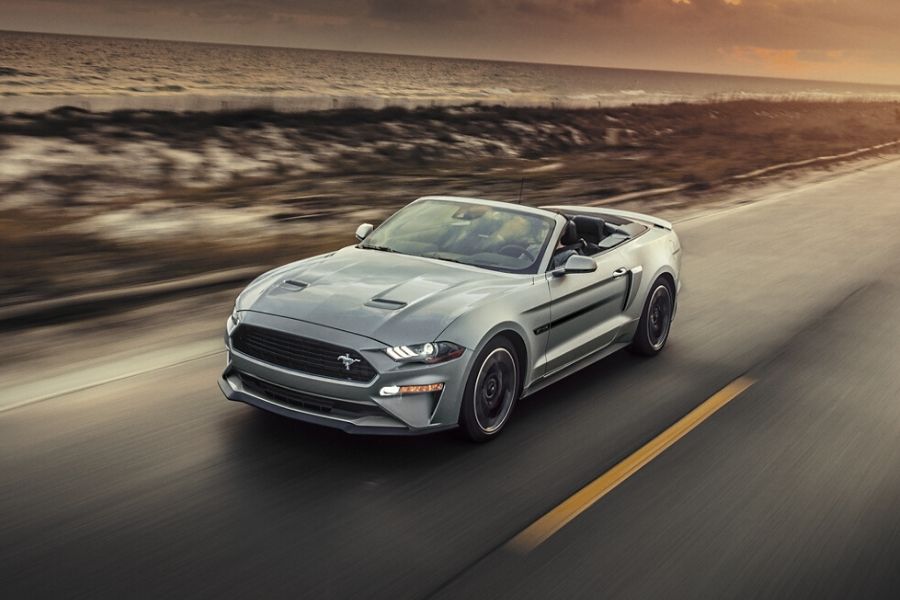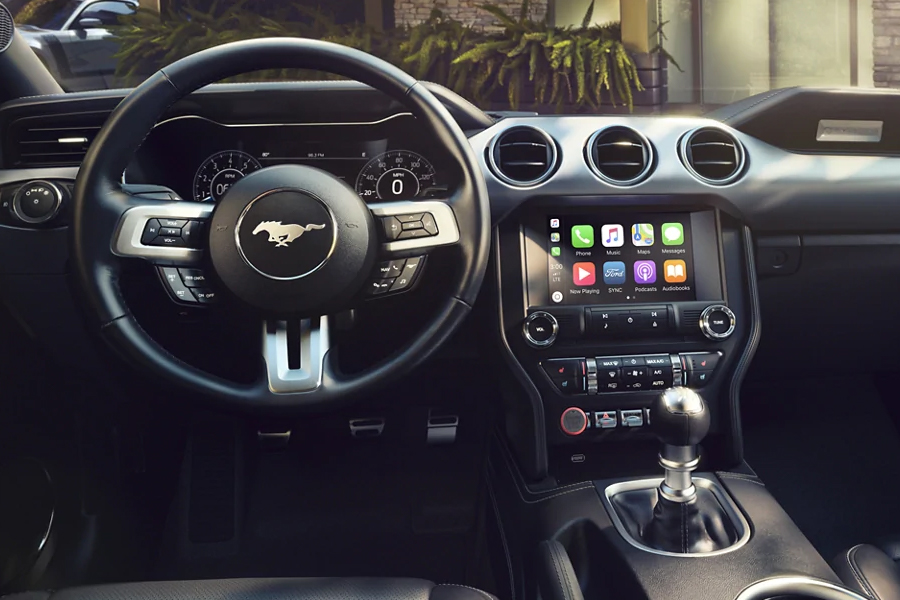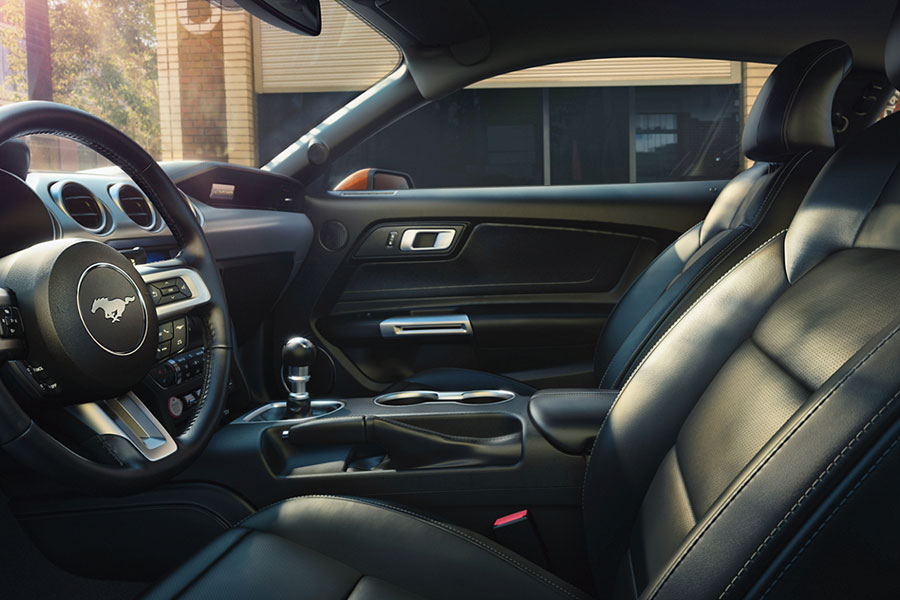The age-old question of “Ford Mustang or Dodge Challenger?” is back. If you’re in the market for a new muscle car, then we have you covered! We have done the hard work for you and put together a side by side comparison of these two legends.
Price
In terms of price, they don’t differ much, with the Mustang starting at $26,670 and the Challenger starting at $28,095. The top available trim for the Mustang starts at $72,900 in comparison to the Challenger’s top trim at $78,695.
Fuel Efficiency
The Challenger gets a fair fuel efficiency of up to 19 mpg City / 30 mpg Highway. However, the Mustang steps things up a notch by getting up to 21 mpg City / 31 mpg Highway.

Power / Performance
When it comes to muscle cars, we all know that power and performance matter most. With five and six engine options for the Challenger and Mustang respectively, we are not in short supply for powerful options in either vehicle. Here is a list of the available engine options for both cars along with their corresponding power output.
Mustang Engine Options:
- 2.3L EcoBoost Engine:
*Notes: Turbocharged and direct injected with twin independent variable cam timing.
- 310 horsepower
- 350 lb. ft. torque
- 2.3L High Performance EcoBoost® Engine:
*Note: Active exhaust with quad tips has 90% of available torque from 3,000 rpm to the red line and is the most powerful in-line four-cylinder in America, and the most powerful EcoBoost engine ever placed into a Mustang.
- 330 horsepower
- 350 lb. ft. torque
- 5.0L To-VCT (GT) Engine:
*Note: Port fuel direct injection is available with High Performance Package.
- 460 horsepower
- 420 lb. ft. torque
- 5.0L To-VCT V8 (BULLITT) Engine:
*Note: Takes the standard 5.0L from the GT and adds a 97 milimeter air intake for enhanced horsepower and torque. Available with the High Performance Package.
- 480 horsepower
- 420 lb. ft. torque
- 5.2L NA To-VCT V8 (Shelby GT350®) Engine:
*Note: Has a redline of 8,250 rpm making it the highest-revving production V8 Ford has ever created (standard on Shelby GT350® and Shelby® GT350R).
- 526 horsepower
- 429 lb. ft. torque
- 5.2L Supercharged Cross-Plan Crank V8 (Shelby GT500®) Engine:
*Note: The most powerful production Mustang engine to date, able to go 0-60 mph in the mid 3 second mark, ¼ mile in sub 11 seconds, and comes standard on the Shelby GT500®. This engine is the most power-dense supercharged V8 production engine in the world.
- projected over 700 horsepower
- 625 lb. ft. torque
Mustang Transmission Options:
- 10-speed automatic
- TREMEC® six-speed manual
- TREMEC seven-speed dual-clutch
Challenger Engine Options:
- 3.6L Pentastar® V6 Engine:
*Notes: Paired with an eight-speed transmission, comes standard on SXT and GT trims with Rear Wheel Drive and has available All-Wheel Drive.
- 303 horsepower
- 268 lb. ft. torque
- 5.7L HEMI® V8 Engine:
*Note: Comes standard on the R/T trim.
- 375 horsepower
- 410 lb. ft. torque
- 392 HEMI® V8 Engine:
*Note: Has best-in-class under $40,000 dollars horsepower and torque.
- 485 horsepower
- 475 lb. ft. torque
- Supercharged 6.2L HEMI® SRT® Hellcat V8 Engine:
- 717 horsepower
- 656 lb. ft. torque
- Supercharged 6.2L High-Output HEMI® SRT® Hellcat Redeye V8 Engine:
- 797 horsepower
- 707 lb. ft. torque
Challenger Transmission Options:
- Six-speed manual
- TORQUEFLITE® eight-speed automatic
- Electronic Shifter
The Challenger offers four braking systems including a Sport Brake System, Performance Brake System, Brembo Four-Piston Brake System, and Brembo Six-Piston Brake System, whereas the Mustang doesn’t. The Mustang does, however, offer seven performance packages and has available Selectable Drive Modes which include: Normal, Snow/Wet, Sport, Track, and Drag Strip.
Options
There isn’t a short supply of trim options for these muscle cars.
The Mustang trim options are as follows: EcoBoost® Fastback, EcoBoost® Premium, EcoBoost® Convertible, GT Fastback, EcoBoost® Premium Convertible, GT Premium Convertible, GT Premium Fastback, BULLITT™, Shelby GT350®, Shelby® GT350R and Shelby® GT500®.
The Challenger trim options are as follows: SXT, GT, RT, RT Scat Pack, RT Scat Pack Widebody, SRT Hellcat, SRT Hellcat Widebody, SRT Hellcat Redeye, and SRT Hellcat Redeye Widebody.
Infotainment
The Mustang’s available 12” LCD Digital Instrument Cluster with MyColor® allows you to fully customize the appearance and color of your instrument cluster. The Challenger has an available 7” digital instrument cluster, however it doesn’t have the extensive customizable options that the Mustang’s cluster has.

Both vehicles have their own version of infotainment and displays. The Mustang has an available SYNC® 3 System which comes with more intuitive touchscreen capabilities that function like a smartphone interface. It also has enhanced voice control capabilities compared to the previous version, and has better smartphone connectivity then in previous versions. It comes with Apple CarPlay® and Android Auto™ connectivity, integrated navigation, and AppLink® which allows you to stay connected to your Amazon Alexa devices at home from your car. The SYNC® 3 system also comes ready to connect to your FordPass® app, giving you access to remote features such as lock and unlock capabilities and remote start capabilities.
The Challenger has an available Uconnect® 4C NAV infotainment system which features Apple CarPlay® support, Android Auto integration, and Navigation like the Mustang. It also comes with all the same Bluetooth connectivity and HD Radio™ technologies included in the Mustang’s SYNC® 3 infotainment system.
Both vehicles have available USB ports for device charging and come standard with a 6-speaker audio system. The Challenger’s available upgraded audio system is a smaller 9-speaker Alpine® Audio Group sound system with subwoofer, versus the available 12-speaker B&O South System with CD Player and subwoofer found in the Mustang.
Interior Comfort
The Mustang’s interior is relatively smaller when compared to the Challenger. Where the Challenger can hold up to five passengers the Mustang only has the capacity to carry four.
The Mustang and Challenger both have available Dual-Zone Electronic Automatic Temperature Control, available leather-trimmed heated and cooled front bucket seats, and an available leather-wrapped steering wheel. The Challenger adds to these available features by offering five different wheel options among its many trim configurations.
Interior Convenience
Remote keyless entry with push-button start can be found in both vehicles, however the performance tracking capabilities vary greatly between these competitors. The Challenger is more limited to the abilities of a 0-60 time tracker and lap timer. On the other hand, the Mustang’s Track Apps™ can instantly provide many different performance metrics in the instrument cluster. The accelerometer function displays lateral and longitudinal g-forces, can display acceleration times and lap times, and includes an automatic countdown to start.

The Mustang also has an available Remote Start System, whereas that isn’t available in the Challenger. However, this feature has been known to be easily purchased and installed through aftermarket kits for those do-it-your-selfers out there who want this feature on the Challenger.
Safety
The safety features for both performance cars are well-rounded. They both come standard with a rearview camera, Stability Control Systems, and a driver’s knee airbag. Both vehicles also have available safety features such as Pre-Collision Assist with Automatic Emergency Braking, Adaptive Cruise Control, Blind Spot Information System with Cross-Traffic Alert, Auto High Beam headlamps, and Rain-Sensing Wipers.
The Mustang offers some additional standard features that aren’t found on the Challenger such as an SOS Post-Crash Alert System™ and a Glove-Box-Door-Integrated Knee Airbag for the front passenger. The AdvanceTrac® with Electronic Stability Control (ESC) that comes standard on the Mustang takes protection a step further aiding in preventing oversteering and understeering. There is also a Lane Keeping System available to add on the Mustang.
Conclusion
Whether on the track or on the open road, the Mustang and Challenger offer unique advantages for both. The more affordable price, better fuel efficiency, and more powerful standard engine are all advantages the Mustang offers over the Challenger. On the other hand, the Challenger’s most powerful engine produces a greater amount of raw power than the Mustang. Both cars have their own versions of performance and trim options with uniquely impressive features. They also both offer strong infotainment packages, however the Mustang offers some useful features not found in the Challenger. With these added features, the extra optional safety features, and upgraded interior performance tracking features, the Mustang comes out just slightly ahead of the Challenger in this fight.